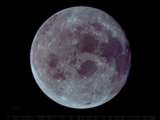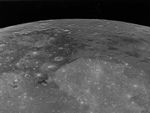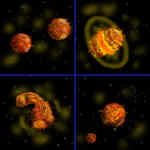 The
Moon is the sole natural satellite of the Earth. Like all the planets
and satellites in the Solar System, the Moon shines by reflected sunlight.
It revolves around the Earth from west to east at a distance of about
384,400 km. With a diameter of 3,476 km, the Moon is less than one-third
the size of the Earth, is only 1/81 as massive as the Earth and has a
density of roughly 3.34 g/cm3, compared to 5.52 g/cm3
for the Earth.
The
Moon is the sole natural satellite of the Earth. Like all the planets
and satellites in the Solar System, the Moon shines by reflected sunlight.
It revolves around the Earth from west to east at a distance of about
384,400 km. With a diameter of 3,476 km, the Moon is less than one-third
the size of the Earth, is only 1/81 as massive as the Earth and has a
density of roughly 3.34 g/cm3, compared to 5.52 g/cm3
for the Earth.
The combined effect of its mass and size gives the Moon a gravity on its surface of 1/6 of the Earth's. This is not enough for the Moon to retain an atmosphere, and so liquid water cannot exist on the Moon. However, in recent years, we have seen evidence that suggests that water ice may exist at the Moon's poles, in regions that sunlight can never reach.
The lack of an atmosphere means that the temperature on the surface of the Moon varies greatly from day to night. During the day, temperatures rise above 100°C, the boiling point of water on Earth, while at night they fall to temperatures lower than would be experienced in Antarctica in midwinter.
Captured Rotation
The Moon rotates about its own axis every 27.32 days. This is the same
time that it takes to orbit the Earth! This is no coincidence: the Moon
is said to be in "captured rotation", or "synchronous rotation".
There is no doubt that the Moon originally rotated more rapidly but, over
a long period of time, the differences in shape and mass distribution
on the Moon have slowed its rotation so that its rotation and revolution
periods are the same. As a result, the Moon always presents the same face
to the Earth.
The situation can be likened to attaching a string to one side of a ball, and then swinging it around your head: the ball will always keep the same face toward you, and you will never see the other side.
With respect to the Sun, however, the Moon rotates every 29.53 days. This period corresponds to a complete lunar "day". The difference comes about because of the motion of the Earth-Moon system around the Sun while the Moon is revolving around us. The Moon must move around its orbit for a little over two more days for the same part of the Moon to face the Sun again. Therefore, daylight on the Moon lasts a little over two Earth weeks, as does a lunar night!

|
The lunar day. |
Surface features
The surface of the Moon has been viewed through telescopes from the time
of Galileo's first observation in 1609. The three main visible features
are the craters, light highland areas and the dark "maria".
In 1651, the Italian Jesuit astronomer Giovanni B. Riccioli described the dark areas on the Moon as seas of water, with names such as Mare Imbrium ("Sea of Showers") and Mare Nectaris ("Sea of Nectar"). These names continue to be used today even though we know now that the Moon is completely devoid of liquid surface water.
 The
craters, which measure up to 200 km in diameter, are found all over the
surface; many can be seen even using binoculars. In the past there was
much debate as to whether their origin is volcanic or related to bombardment
by impacting bodies. However, we now have sufficient evidence that the
Moon's surface has been shaped primarily by impacts. Indeed, the individual
craters that we see today are likely to be all, or almost all, of impact
origin.
The
craters, which measure up to 200 km in diameter, are found all over the
surface; many can be seen even using binoculars. In the past there was
much debate as to whether their origin is volcanic or related to bombardment
by impacting bodies. However, we now have sufficient evidence that the
Moon's surface has been shaped primarily by impacts. Indeed, the individual
craters that we see today are likely to be all, or almost all, of impact
origin.
The darker areas of the Moon, the "maria", have fewer craters and are thought to be huge lava flows that have spread over an area, destroying the craters that had already been formed. Another type of feature is the rille, a deep trench that may extend several hundred kilometres. Rilles tend to occur in groups within mountain ranges bordering maria or craters.
 Origin
of the Moon
Origin
of the Moon
Most scientists favour the giant-impact hypothesis. According to this
theory, a Mars-sized body struck the proto-Earth early in the history
of the Solar System. As a result, a cloud of fragments was ejected into
orbit around the Earth, later accreting into the Moon.
Prior to the collision, the proto-Earth and the other Mars-sized body had already formed metallic cores and silicate-rich mantles. Upon collision, the higher density metallic cores coalesced to form the Earth's core, with lower density silicates forming the outer part of the Earth or being ejected into space to eventually either fall back to Earth, collide with other nearby planets, or form the Moon.
| Copyright owned by the State of Victoria (Department of Education and Early Childhood Development). Used with Permission. |
|
|||||||||||||||||||||||